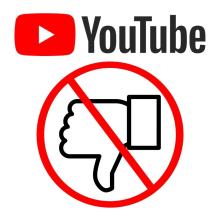
In early November 2021, YouTube announced its decision to remove the public-facing “Dislike” count from all videos on the platform. While this change has yet to be active for most users, the update is likely to go into effect within the next month.
The decision has YouTube users and creators split on the purpose and importance of seeing content Dislikes. Some say that public Dislikes can have a disproportionately negative impact for content creators, while others claim that there are benefits to users being aware of video counts.
Will the Dislike Button Disappear?
It’s important to note that the Dislike button will not be disappearing from the platform. That button will still be active as an active tool for YouTube’s algorithm. As a YouTube User, using the like and Dislike buttons is vital for helping guide the algorithm to continue showing you content you might enjoy and omitting content you may not enjoy.
Furthermore, Dislike counts for each video will remain visible to the creator as a means of providing feedback, although the count totals will no longer be public-facing.
YouTube’s Reason for Removing Public Dislike Counts
The Internet allows countless opportunities for the general public to post both positive and negative online reviews for local businesses, e-commerce products, books, and pretty much everything else. So what makes YouTube videos different?
YouTube’s reasons for removing the public-facing Dislike counts come down to how users and creators use (or abuse) the feature. It’s not uncommon for dueling video creators to source Dislikes for competing videos, either by crowdsourcing or from fake accounts. Videos with a higher number of Dislikes are less likely to continue being viewed, affecting the video’s revenue stream. Additionally, an increased number of crowdsourced Dislikes can also push the video lower in search results, giving other videos on the same topic an unfair advantage.
With so many YouTube creators finding fame, YouTube has also experienced a surge of video Dislikes based on creators’ political or personal stances. This type of behavior defeats the purpose of the video’s Dislike option, as the statistic grows more and more likely to be unrelated to the video itself. Even so, it can be difficult or even impossible for YouTube to monitor each user’s genuine intent. While the Dislike option may have once held a functional purpose, that purpose seems to have lost validity and become more divisive over time.
Where most other review platforms have at least some measures to limit displaced negativity or fake reviews, YouTube allows anyone to create an account and browse, watch, post, and interact with all content. The freedom to watch and share content without some of the membership restrictions put in place by other platforms paves the way for a “Wild West'' effect when it comes to keeping unfounded negativity under control. YouTube’s decision to remove the Dislike review count will help eliminate some of the abusive or otherwise inappropriate behavior experienced throughout the platform.
Other Pros for Removing YouTube Dislike Counts
While YouTube’s reasons for removing the Dislike count will help cut down on unfair user and creator behavior, other positives may result from YouTube’s decision.
From the very beginning, YouTube has striven to be a video platform for the people, where anyone can share their unique content. In this respect, YouTube is a social media platform, and also the only large social network employing a straightforward Dislike option for its users. Other social giants such as Instagram and TikTok allow for hearts and comments, and in Facebook’s case, users can also reply using a variety of reactions. Any option for a negative reply is either implied using a particular reaction or added as a written comment.
When looking at it from this angle, YouTube’s Dislike option seems significantly more polarizing than that of its competitors. It’s safe to say that the public display of YouTube’s Dislike counts might discourage the average independent user from posting unique content due to the fear of public scrutiny or of not measuring up to the bigger-name YouTube stars. While removing the Dislike count won’t necessarily change that fear, it does reduce the threat of being publicly viewed as “disliked.” Considering overwhelming research stating that social media can profoundly impact a user’s self-esteem and overall mental health, it’s hard to argue with a decision designed to help lighten the adverse effects YouTube may have on its users.
In recent years, YouTube has also been grouped more closely alongside streaming platforms such as Netflix and Hulu, which both allow users to privately Like or Dislike video selections. Though, along the same vein as YouTube’s recent decision, the statistics of the counts on these streaming platforms are no longer public.
The Cons for Removing Dislike Counts from YouTube
It may be surprising to find out that many YouTube creators oppose YouTube’s decision to hide Dislike counts, claiming that Dislikes help users distinguish which videos may contain low quality, deceptive, or otherwise unfavorable content. A video that has 1000s of Likes may appear favorable. Still, if the same video receives 10,000 Dislikes, a public display of that dichotomy can help signal to the user that there may be something wrong with the video.
Another argument favoring the public Dislike count is that it helps signal a situation where a creator may be purchasing Likes. If a video receives many Likes all at once but then lives on to continue receiving Dislikes over time, this helps signal to both users and YouTube’s algorithm that the creator may be using deceptive techniques.
The General Consensus
YouTube’s decision to remove public-facing Dislike counts may leave its users on opposite sides of the spectrum. However, what it comes down to in the end is what is ultimately fair for the streaming and social media hybrid platform.
In recent years, we’ve seen similar decisions from other streaming platforms in order to create a less polarizing environment for content creators and users alike. We’ve also experienced a worldwide strive towards less caustic social media practices.
Regardless of what side you take, it’s easy to understand YouTube’s shift towards creating a more favorable environment for its users.
